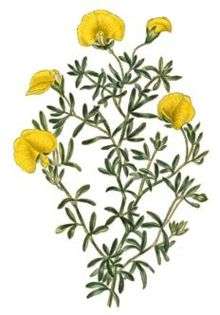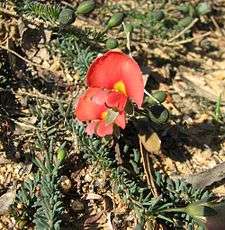Gompholobium
| Gompholobium | |
|---|---|
 | |
| Gompholobium virgatum | |
| Scientific classification | |
| Kingdom: | Plantae |
| (unranked): | Angiosperms |
| (unranked): | Eudicots |
| (unranked): | Rosids |
| Order: | Fabales |
| Family: | Fabaceae |
| Subfamily: | Faboideae |
| Tribe: | Mirbelieae |
| Genus: | Gompholobium Sm. |
| Species | |
|
See text. | |
Gompholobium, commonly known as glory peas or wedge-peas, is a genus of plants in the pea family, Fabaceae and is endemic to Australia. Most species have compound leaves composed of three leaflets and all have ten stamens which are free from each other and a distinctive arrangement of their sepals.
Description
Plants in the genus Gompholobium mostly have leaves composed of three separate leaflets but some species have simple leaves and others have pinnate leaves. The leaflets are arranged alternately along the stems and are usually narrow and have smooth edges. The flowers are usually arranged in groups on the ends of the branches, sometimes singly or in pairs. The sepals form a short tube with five lobes longer than the tube. The large "standard" petal at the back of the flower is circular to kidney-shaped and is larger than the other petals. There are ten free stamens and the ovary is glabrous. The fruit is an oblong to almost spherical legume containing two to many ovules.[1][2]

Taxonomy and naming
The genus Gompholobium was first formally described in 1798 by James Edward Smith and the description was published in Transactions of the Linnean Society of London.[3][4] In 2008, Gompholobium grandiflorum was designated the lectotype.[5] The genus name is derived from the Ancient Greek words gomphos, meaning "bolt", "peg" or "nail"[6]:545 and lobos meaning a "capsule" or "pod"[6]:118 referring to "the inflated shape of the seed pods".[7]
Distribution
Glory peas are found in all states of Australia.
Species include:
- Gompholobium aristatum Benth.
- Gompholobium aspalathoides A.Cunn. ex Benth.
- Gompholobium baxteri Benth.
- Gompholobium burtonioides Meisn.
- Gompholobium capitatum A.Cunn.
- Gompholobium cinereum Chappill
- Gompholobium confertum (DC.) Crisp
- Gompholobium cyaninum Chappill
- Gompholobium ecostatum Kuchel - dwarf wedge-pea
- Gompholobium foliolosum Benth.
- Gompholobium gairdnerium Chappill
- Gompholobium glabratum DC.
- Gompholobium glutinosum Chappill
- Gompholobium gompholobioides (F.Muell.) Crisp
- Gompholobium grandiflorum Sm.
- Gompholobium hendersonii Paxton
- Gompholobium huegelii Benth. - common wedge-pea
- Gompholobium inconspicuum Crisp - creeping wedge-pea
- Gompholobium knightianum Lindl.
- Gompholobium latifolium Sm. - giant wedge-pea
- Gompholobium marginatum R.Br.
- Gompholobium minus Sm.
- Gompholobium muticum (Benth.) Chappill
- Gompholobium nitidum Sol. ex Benth.
- Gompholobium obcordatum Turcz.
- Gompholobium oreophilum C.F.Wilkins & Trudgen[8]
- Gompholobium ovatum Meisn.
- Gompholobium pinnatum Sm.
- Gompholobium polymorphum R.Br.
- Gompholobium polyzygum F.Muell.
- Gompholobium preissii Meisn.
- Gompholobium pungens Chappill
- Gompholobium roseum Chappill
- Gompholobium scabrum Sm.
- Gompholobium shuttleworthii Meisn.
- Gompholobium simplicifolium (F.Muell. & Tate) Crisp
- Gompholobium subulatum Benth.
- Gompholobium tomentosum Labill.
- Gompholobium uncinatum A.Cunn. ex Benth.
- Gompholobium venulosum Lindl.
- Gompholobium venustum R.Br.
- Gompholobium villosum (Meisn.) Crisp
- Gompholobium virgatum Sieber ex DC.
- Gompholobium viscidulum Meisn.
- Gompholobium wonganense Chappill
References
- ↑ Wiecek, Barbara. "Genus Gompholobium". Royal botanic Garden Sydney: plantnet. Retrieved 26 October 2016.
- ↑ Payne, William H. "Gompholobium: The Glory Peas". Australian Native Plants Society Australia. Retrieved 26 October 2016.
- ↑ "Gompholobium". APNI. Retrieved 26 October 2016.
- ↑ Smith, James Edward (1798). "The Characters of Twenty New Genera of Plants". Transactions of the Linnean Society of London. 4: 220. Retrieved 26 October 2016.
- ↑ "Gompholobium". APNI. Retrieved 26 October 2016.
- 1 2 Brown, Roland Wilbur (1956). The Composition of Scientific Words. Washington, D.C.: Smithsonian Institution Press.
- ↑ "Gompholobium latifolium". Australian Native Plants Society Australia. Retrieved 26 October 2016.
- ↑ Wilkins, Carolyn F.; Malcolm E. Trudgen (23 March 2012). "A new species of Gompholobium (Fabaceae: Mirbelieae) from the Pilbara bioregion of Western Australia" (PDF). Nuytsia. 22 (1): 31–40.